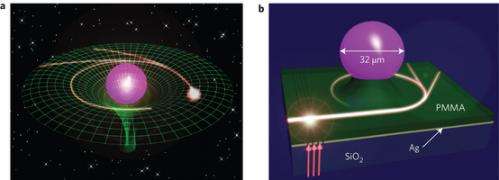September 30, 2013 report
Researchers devise a way to mimic gravitational lensing in a way that can be seen

(Phys.org) —A team of researchers working at China's National Laboratory of Solid State Microstructures and Department of Physics has developed a means for mimicking gravitational lensing in a way that allows for viewing laser light actually being bent around a sphere. In their paper published in the journal Nature Photonics, the team describes how they constructed their microstructure, how it works and ways it might be used for a practical purpose.
Physicists have known for almost a century that when light passes by an object, it is bent by the object's gravitational pull. The bigger an object, or the stronger its gravitational pull, the more light can be bent. With an object such as a black hole, the pull can be so great as to cause the light to bend all the way around it, creating what is known as a photon sphere. In the real world, such events cannot be witnessed of course, because the light becomes trapped. In this new effort, the researchers sought to create a structure that would mimic light being bent around a sphere, but in a way that would allow it to be seen.
The structure the team built is based on refracted light and the fact that different materials diffract light a different amount. The team started with a microscopic sized ball of polystyrene. They then used a spin coating process to cover the central sphere with a polymer coating—the spin technique allowed for varying the thickness of the polymer creating a material with a constantly changing degree of refraction. The varying degrees of refraction caused a laser light shone through the sphere to bend, effectively mimicking the action of black hole. But, because the light was being refracted into the center of the sphere, the researchers wouldn't be able to see it—also just like a black hole. To get around this problem the researchers added quantum dots to the polymer coating—they absorbed a small amount of the laser light and then emitted it as red light—at an angle—directing it towards the researchers who recorded it all on videotape.
In the video, the light from the laser can be seen bending as it's brought close to the sphere, eventually reaching a point where it's bent all the way around the sphere, creating an artificial photon sphere. The structure mimics a black hole and thus conforms to Einstein's theory of general relativity, and for that reason, the researchers believe it can be used as a research tool. They suggest it might also prove useful in directing light onto solar cells.
More information: Trapping light by mimicking gravitational lensing, Nature Photonics (2013) DOI: 10.1038/nphoton.2013.247
Abstract
One of the most fascinating predictions of the theory of general relativity is the effect of gravitational lensing, the bending of light in close proximity to massive stellar objects. Recently, artificial optical materials have been proposed to study the various aspects of curved spacetimes, including light trapping and Hawking radiation. However, the development of experimental 'toy' models that simulate gravitational lensing in curved spacetimes remains a challenge, especially for visible light. Here, by utilizing a microstructured optical waveguide around a microsphere, we propose to mimic curved spacetimes caused by gravity, with high precision. We experimentally demonstrate both far-field gravitational lensing effects and the critical phenomenon in close proximity to the photon sphere of astrophysical objects under hydrostatic equilibrium. The proposed microstructured waveguide can be used as an omnidirectional absorber, with potential light harvesting and microcavity applications.
Journal information: Nature Photonics
© 2013 Phys.org


















